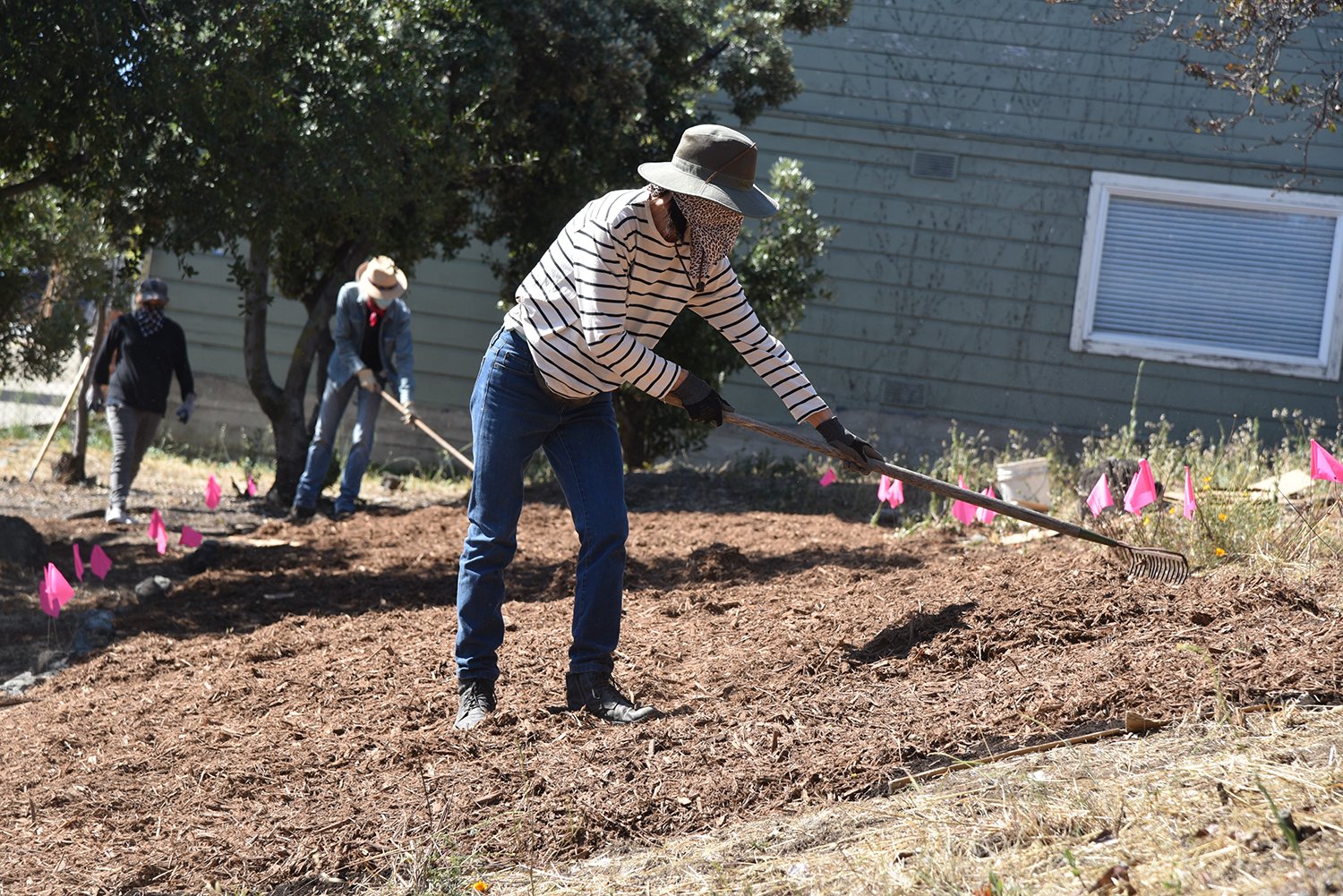
Mulch Belongs in Your Wildfire Resilient Garden

Contributor
- Topics: Drought and Fire Resilience
Winter 2024
There’s a lot of pressure on our landscapes to protect our properties from fire, but it may be an unrealistic expectation. Research indicates that 60–90 percent of homes that ignite burn when embers hit litter on roofs and in rain gutters, melt through vinyl screens, and fly through unprotected vents, igniting the home before a flame front arrives (Bohannon 2021).
When a fire is coming toward your property, the space closest to your building should be as nonflammable as feasible. This innermost defensible zone is the most critical for preventing a structure from igniting at the ground level, and is measured from the walls of your building (including things like decks and stairs) outward. Most commonly, this zone is codified to be the first five feet (about 1.5 meters), but that may vary depending on where you are. Many ordinances have been changing to more tightly control what is allowed in the landscape so close to buildings.
Avoiding mulch near structures is common advice. The idea that mulch will ignite in a wildfire and cause our homes to burn sounds reasonable and frightening. This leads many to decide that mulch is the enemy and be done with it. While it is easy to vilify mulch and not give it a second thought, that limited perspective ignores the many benefits of mulching and how those benefits could make plants harder to ignite.
Mulch is specifically a topdressing (not worked into the soil, but placed on top) of any material that is used to protect the soil from the elements. Mulch is a horticultural tool that helps keep plants healthier, better hydrated, and less stressed than they would have been without it. If you’re growing plants within that inside defensible zone, you should be working for soil and plant health, not removing mulch and hampering it. Well-hydrated, healthy plants are harder to ignite than stressed, dehydrated plants, regardless of species. Don’t rely on any plant to protect you, but if a fire comes along, it makes sense to have the outdoor spaces adjacent to buildings and exit routes be as hard to ignite as feasible.
If it is clear for your circumstances that this inner zone must change to mitigate fire risks, it may be time to reconsider the design of these outdoor spaces. Rather than merely removing mulch and risking a decline in the health and hydration of remaining plants, rethink the layout. The better solution might be to change the layout of your property so that paving is next to the building, potentially making more room for gardening farther out. Moving paths and patios isn’t cheap, but replacing a home is far more expensive, disruptive, and environmentally costly.

Reasons to use mulch
Mulch is a layer of material on top of the soil. It protects the soil, making the conditions underneath better for plant and soil health. A healthy, appropriately hydrated plant will be harder to ignite than a plant suffering from stressors such as drought-stress, heat stress, or pests, regardless of species.
Soil moisture
Mulches prevent moisture from evaporating out of the soil by insulating the soil from dry air, wind, and higher temperatures. Plants can stay healthier and better hydrated when the moisture in the soil is more consistently available.
Weed suppression
Mulch reduces competition from weeds, which allows soil moisture and nutrients to stay more available to your plants.
Consistent temperatures
With that insulating layer of mulch, temperature extremes from the weather take longer to get to the soil, so it cools off and warms up more slowly. Having more consistently comfy soil without temperature whiplash reduces stress on plants, and less stress can keep plants healthier.
Soil health
Healthy soil supports healthy plant growth by hosting beneficial microorganisms including molds, fungi, bacteria, and protozoa. All that life in the soil keeps pathogens at bay, makes more soil moisture available to plants, and turns organic material and minerals into plant-available nutrients. Organic mulch in particular fosters soil health by providing all the previously mentioned benefits and also by decomposing into organic material that becomes part of the soil and sustains the life in the soil.

Flammability factors
Not all mulches are created equal. There are differences in 1) how easily ignited mulches are, 2) how well they sustain flame or smoldering, and 3) whether they’re totally consumed by the fire. These three characteristics are informed by how the mulch material is structured, what its chemical make-up is, and how much moisture is in it.
For example, in starting a campfire, we look for dry, thin twigs to use as kindling, we don’t try to first ignite a freshly cut thick log. Then we light the kindling with a match that boasts a little dab of an oxidizing agent on the match head to get things started. In this example, the structural component would be that surface-area-to-volume ratio of kindling versus log. The moisture content would be different between a freshly cut piece of wood and dry twigs, or the match that was made deliberately to be thin, dry, and burn easily. The chemical component here, the match head, represents varying chemical properties in and around mulch, like the difference between a plant with sticky sap which may be more easily ignited than a plant with watery sap. We understand intuitively that the log will sustain a fire longer but will be harder to ignite and could go out before the whole thing is burned up. These same concepts can apply to mulches.

Wildfire and Your Landscape: What you Need to Know
By: Pacific Horticulture
Fire Preparedness Aritcles and Resources

Benefits of Mulch in Regulating Soil Temperature
By: E. Thomas Smiley, Ph.D. and Sean Henry, Bartlett Tree Research Lab
One of the best things a gardener can do to help the trees in their care is to add an appropriate mulch ring around the base, ideally 2 to 4 inches deep, as wide as the drip line of the tree, while avoiding “mulch volcanoes”, a situation where mulch is piled up against the trunk. >> Read More
Kinds of mulches and their trade-offs
Rubber
Rubber should not be used to mulch plants. Recycled rubber is better suited to playground products and other non-horticultural uses. Rubber used as a mulch in planting beds is something only its manufacturers think is a good idea. Their claims that rubber is a permanent, no-maintenance, non-toxic alternative have been debunked (Chalker-Scott, no date). In the event of a fire, rubber is more easily ignited, burns hotter, and is more difficult to extinguish than other mulches. It is just too dangerous and fails to provide the same benefits as other mulches (Quarles, 2011).
Inorganic mulches
While inorganic mulches like rocks, gravel, and grass cullet are nonflammable, their performance for most garden plants is lackluster. The weight of these kinds of mulches compacts soil, which harms soil health. While they don’t biodegrade and last longer, this attribute fails to support soil health because no organic matter is added to the soil. These mulches work in gardens with plants that favor leaner, drier soils because the mulch does not conserve soil moisture as well as organic mulches. Inorganic mulches are also less effective at insulating soils against temperature extremes. Weeds are harder to pull out from the compacted soil. Organic material like leaves and weeds will still build up on top and must be cleaned out regularly to keep it maintained for nonflammability.
Large woodchips
Bigger, chunky mulches, like in the example of the campfire above, are less easily ignited than shredded or finer organic materials. Weeds are easier to pull from healthy mulched soil, and the bigger chunks take longer to decompose. Replenishment is necessary as the wood decomposes and becomes part of the soil, but chunkier mulches disappear more slowly than those made with smaller pieces.
Partially composted woodchips
Chunky, partially composted woodchips have an outer layer where humus has begun forming, but the pieces haven’t broken down so far that you can’t tell they’re woodchips. These are possibly the best of all mulch worlds if you can find it. The humus component of the composting process is difficult to ignite and doesn’t hold a flame well. Having a chunky woodchip with humus starting provides all the benefit of regular mulch with the harder-to-ignite traits of compost.
Dyed mulch
Dyed mulches seem like the same thing as other woodchip mulches, but they’re usually made from construction waste like lumber and shipping palettes and crates. These scrapped woods are chipped and dyed for use in the landscape. The dyes are usually not toxic, but other contaminants might sneak in from the source material (like bits of pressure-treated wood). These mulches make use of material that might otherwise go to the landfill. Some people like the uniformity of the dyed colors over natural material colors. Unfortunately, the wood they’re made from is dried to make them more durable, pest resistant, and lightweight for construction and shipping. The loss of moisture in the drying process makes them slower to decompose and probably easier to ignite than greener (higher moisture content) woodchips. Because they’re dry, they won’t break down as fast, so humus takes longer to start forming. They’ll be more buoyant if the planting bed floods, and be more easily displaced by strong winds, foot traffic, and water because of both their lighter weight and their inhibited decomposition.
Shredded mulch
Shredded woods or fine organic materials like needles and straw have more surface area compared to their weight, so you can expect them to ignite easily, like a fine kindling. If you have a tree that drops needles, it is not necessary to rake all that stuff up and replace it, but don’t let it build up to be too thick on the ground. The good news is that while these kinds of materials are extremely quick to ignite, they will probably burn up completely very quickly. One study suggested that some shredded mulches might only burn on the surface if the mulch was tightly matted enough, but that a fire would take advantage of any pocket of air, negating this potential benefit (Zipperer et. al 2010).
Arbor mulch
Using trimmings is a wonderful way to keep green waste out of the landfill. With the variety of materials (leaves, twigs, bigger chunks), the finer pieces break down more quickly, starting the humus process, but the chunkier pieces last longer. An alternative to commercially made products, sometimes these mulches are cheap or free depending on local ordinances on green waste disposal.
Compost
When compost is used as a topdressing, it could be viewed as a mulch, but it affords the soil less insulating protection since the air pockets between particles aren’t really there. Compost won’t hold in soil moisture or keep soil temperatures steady like woodchips will, but the organic content can make soil moisture more plant available, especially if you have soils that hold moisture too tightly (like predominantly clayey soils). Also consider that if you add compost annually to plantings that can’t handle the extra moisture retention and organic material, it can be too rich for those plants and stress them out.
Living mulch
Technically plants are not really mulch, but low-growing, well-chosen, maintained groundcover as a hydrated layer of living material could be an option for those looking to replace a mulch path or avoid the repeated maintenance of replenishing mulch. Plants should be non-woody, very short, and not resinous. They must be kept weed-free and healthy, and watered so that they are not drought stressed. The nice thing about groundcovers as paths is that they’re nice looking, can provide some aspect of wildlife habitat, help sequester carbon, and sink water into the ground. If the mulch is non-woody, they shouldn’t hold a flame very long if they do ignite, and if they are low enough, the height of a flame will be relatively short. Growing low groundcover eliminates the need to reapply mulch, because there isn’t any. Before trying this, look into whether the regulations of insurance companies, homeowner associations, and so forth will allow it. As with any organic material, groundcovers can dry out from heated air when a fire is nearby. Once dry enough, these low-lying plants can ignite as well as anything else. If local regulations prohibit any plant material, then they’d be part of that rule.

It’s time to change our approach to fires from reactive and fear-based to environmentally and horticulturally sound practices. We can easily steward our gardens as part of a broader climate solution and also keep our properties from going up in smoke. Ignoring the bigger picture for short term stopgap measures like removing mulch and leaving plants stressed and vulnerable won’t work.
Rather than vilify mulches, what we should be afraid of is unhealthy soil, drought-stressed plants, and vulnerable structures. We should be working to keep our landscapes healthy while we harden our homes and make evacuation plans. Mulch is not the enemy. On the contrary, it is one of the weapons we should be using to reduce how easily our landscapes ignite.
We do need to design and maintain our gardens thoughtfully, but we cannot pretend that our plants have the job of defending us and avoid the costs of modifying the way we build homes. Fire scientist Steve Quarles opened my eyes when he once told me it was cheaper and more environmentally responsible to keep the zero-to-five-foot zone nonflammable than to rebuild the whole house. He was right, and I’ve been looking for examples of good design that includes nonflammable materials next to buildings ever since.
This article was sponsored by:
Resources
Bohannon, Sarah. 2021. “It’s Embers, Not Flames That Usually Ignite Homes During A Wildfire – Here’s How To Prepare.” North State Public Radio (Chico, California). July 28, 2021.
Chalker-Scott, Linda. The Myth of Rubberized Landscapes. Washington State University Extension. [pdf]
Chalker-Scott, Linda. 2007. “Impact of Mulches on Landscape Plants and the Environment — A Review.” Journal of Environmental Horticulture 25 (4): 239–249.
Fire Safe Marin. “Fire-Resistant Mulch.”
Hedayati, Faraz, Carolyn Stansell, Daniel Gorham, and Stephen L. Quarles. 2018. “Near-Building Noncombustible Zone.” Insurance Institute for Business & Home Safety.
Kujawski, Ron. 2015. “Colored Bark Mulch.” UMass Extension Landscape, Nursery, and Urban Forestry Program.
Onwuka, B.M. 2016. “Effects of soil temperature on Some Soil properties and plant growth.” Scholarly Journal of Agricultural Science 63 (3): 89–93.
Premier Pallets, Inc. “Reasons Why Distributors Use Heat Treated Wood or Kiln Dried Pallets.”
Quarles, Stephen L., Christine Standohar-Alfano Faraz Hedayati, and Daniel J. Gorham. 2023. “Factors influencing ember accumulation near a building.” International Journal of Wildland Fire 32 (3): 380–387. [pdf]
Quarles, Stephen and Ed Smith. 2011. The Combustibility of Landscape Mulches. University of Nevada Cooperative Extension. [pdf]
Rogstad, Alix, Tom DeGomez, Chris Hayes, Jeff Schalau, and Jack Kelly. 2014. Comparing the Ignitability of Mulch Materials for a Firewise Landscape. The University of Arizona Cooperative Extension. [pdf]
Zipperer, Wayne, Alan Long, Brian Hinton, Alexander Maranghides, and William Mell. 2007. “Mulch Flammability.” In Emerging Issues along Urban-Rural Interfaces II: Linking Land-Use Science and Society, Atlanta, Georgia, April 9–12, 2007, 192–195. [pdf]










Responses